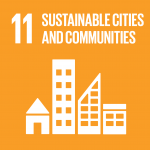A deep dive into Urban Resilience
Submitted by melanie.pisano@... on 05 November 2019

16 October 2019, Penang, Malaysia – If you had 24 hours’ notice to evacuate due to a hurricane or typhoon warning, do you know what route you would take out of the city or where you would go? Do you know if your city even has an evacuation plan? With more than 55% of the world’s populations already living in urban areas, making cities more resilient is key to combating the effects of extreme weather, heat, flooding, and drought risks – all made more severe by climate change.
The Asia-Pacific region has the fastest growing urban population worldwide. Every four years since 1993, the largest regional gathering of urban stakeholders, policymakers from local and national levels, financial institutions, the research community and private sector have convened for the Asia-Pacific Urban Forum to share ideas and advance progress towards sustainable urbanization.
The latest in this series of events, the Seventh Asia-Pacific Urban Forum (APUF-7), was held in Penang, Malaysia from October 15-17, 2019. APUF-7 was a platform for all stakeholders to discuss the challenges and opportunities for cities as they seek to implement the New Urban Agenda, Paris Agreement, Sendai Framework for Disaster Risk Reduction, and the 2030 Agenda across the region.
Together, the United Nations Development Programme (UNDP) with UN-Habitat, the European Union, and the International Urban Cooperation, an EU initiative, organized a Deep Dive Discussion as part of the APUF-7’s focus on urban resilience. The event’s panel hosted an array of voices from government and city entities and research and climate financing institutions. The panel was posed the question: how can national climate action - such as National Adaptation Plans (NAPs), Nationally Determined Contributions (NDCs) and nationally-coordinated climate financing - be leveraged to further climate adaptation in cities?
As host country of the APUF-7, Mr. Ahmad Farid bin Mohammed, from the Malaysian Ministry of Energy, Science, Technology, Environment, and Climate Change discussed the ‘vertical integration’ approaches currently under consideration in the country as part of ongoing discussions on NAP development. Vertical integration is the process of creating strategic linkages between national and sub-national adaptation planning, implementation and M&E. Under consideration in the Malaysian context, the adoption of a National Standing Committee for vertical integration would allow for multiple stakeholders to convene and set policy directions for climate adaptation at both the national and subnational levels in a coordinated manner. In Malaysia many states and cities already have climate adaptation included in their development plans. In contrast, Ms. Pochanie Kajonpredanon, from Thailand’s Department of Public Works and Town & Country Planning shared that the country has a very centralized model, but has started to move towards an approach where cities are encouraged and supported by the national ministries to mainstream climate change into their planning processes.
From Melaka City in Malaysia, Mr. Hafizam Mustaffa provided a key message for how the city has approached climate adaptation planning and budgeting: “if you can monitor, you can manage.” He described how the city has taken several steps to get high quality and localized data relating to mitigation and adaptation actions. Melaka provides a good case of cities taking action autonomously, while also working closely with national and international partners for integrating climate changing into policy planning.
Ms. Cristiana Fragola from the Global Covenant of Mayors for Climate and Energy shared a global perspective based on the work of her organization to share best practices between cities and scale climate action. She highlighted the importance of including cities in national climate change conversations, saying “in the end we live in cities, not in nations.” Vertical integration of climate adaptation planning “is not a myth, it is a need.”
Ms. Katarzyna Rzucidlo from the Green Climate Fund (GCF) further stressed the connection between national and local approaches, saying “Both National Adaptation Plans and project financing are crucial for long-term climate change strategies at the city level”. Clear and well-articulated NAPs are an essential tool to lead to financing at both the national and local levels. So what does this mean for cities? While financing from international sources is available to cities, it can be challenging to access because well-designed projects at the city scale are currently limited in numbers In addition, there is a need to build the case for cities through improved data and evidence. Rzucidlo also emphasised that project proposals have to consider more thoroughly the methodology used, ensuring effective participation of women and youth and complying with environmental and social safeguards principles.
Dr. Sang In Kang from the Korean Environment Institute (KEI) stressed “that one of the major challenges of vertical integration of climate change adaptation is the political uncertainty in local and national governments, including limited term of office for leaders and key decision-makers”. During the Deep Dive Discussion there was an overall consensus for local, national, regional and global integration on understanding climate change impacts and how these impacts are locally specific and all have a unique socio-economic system. There is no one-size-fits-all approach to climate change policy for cities.
The session moderators, Mr. Liam Fee from UN-Habitat and Ms. Laura Hammett from UNDP concluded the discussion by outlining with several key takeaways for the participants. Understanding local capacity is important for project design and should not rely on national data but rather city-specific data – which are often missing or needed. However, for well-designed city-scale projects that rely on sound data, there are financing options available and project implementation should have a more transparent process. Furthermore, there is a need for integrated expertise on climate change adaptation and mitigation plans across various disciplines. This can be achieved through mobilizing academic institutions, such as universities and academia during project elaboration, especially for local projects. Lastly, horizontal communication between ministries and departments at the national level can help facilitate vertical integration for climate adaptation.
Suggested reading:
For a deeper dive into this topic, please see UN-Habitat’s latest publication on “Addressing Urban and Human Settlement Issues in National Adaptation Plans: a supplement to the UNFCCC Technical Guidelines on the National Adaptation Plan Process”. UNDP contributed content to integrating urban issues and the human settlement aspects in National Adaptation Plans in the publication.
